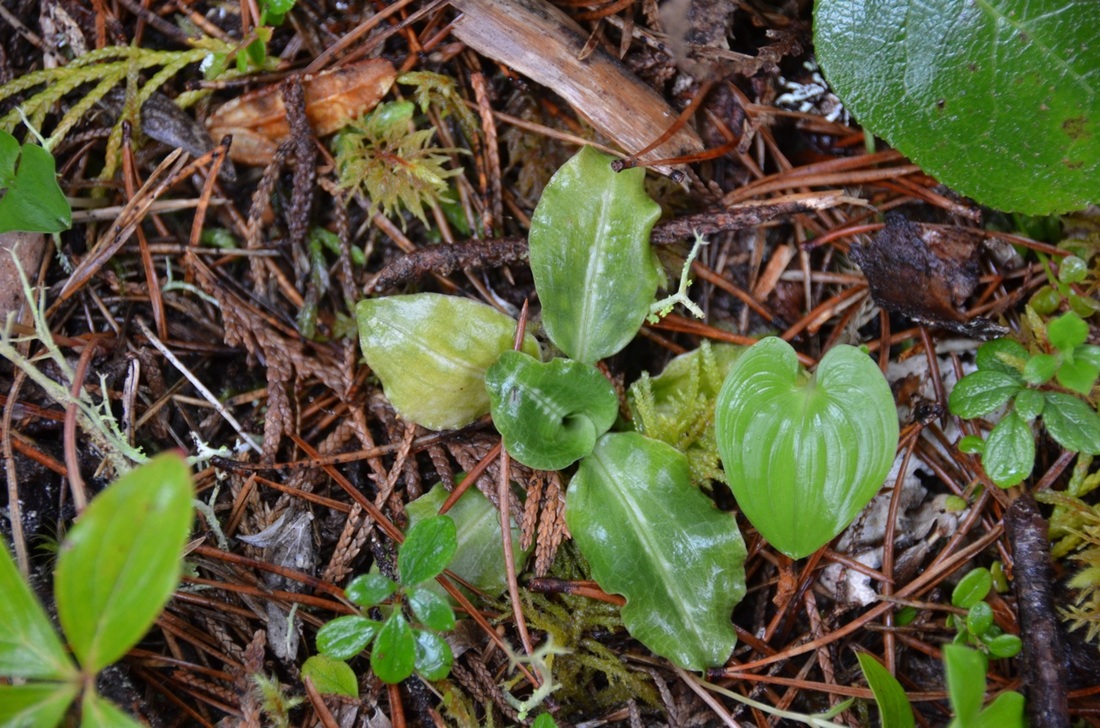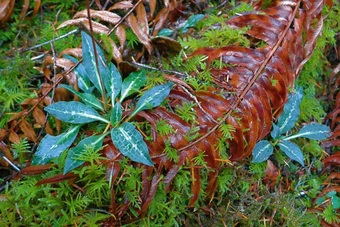Rattlesnake-plantain • Goodyera oblongifolia
{Goodyera = for 17th century English botanist John Goodyer}
Basal leaf rosettes of rattlesnake-plantain. Photos by Kira Hoffman (left) and Todd Carnahan (right).
Identification
Rattlesnake-plantain is an evergreen perennial with stems to 45 cm tall. Its leaves are all basal and form a flattened rosette. The leaves are thick, oval- or elliptic-shaped, and dark green with white mottling or striping particularly along the midrib. The dull white to greenish flowers cluster in a long, dense spike along the end of the stem. Most of the flowers orient to one side.
Habitat & Range
Rattlesnake-plantain grows on humus in shaded, dry to moist coniferous forests from low to middle elevations. It commonly grows among mosses. Its west coast range extends from Alaska to Mexico; it is also found in eastern Canada and parts of the United States (map).
Similar Species
The flattened basal leaf rosette helps differentiate rattlesnake-plantain from orchids with similar terminal flower spikes, such as white bog-orchid (Platanthera dilatata) and ladies' tresses (Spiranthes romanzoffiana). Its leaf shape is similar to that of common plantain (Plantago major), but the latter does not have a flattened leaf rosette.
Human Uses
One traditional use of the plant was as a balloon by Stl'atl'imx children. By rubbing the leaves together the top and bottom layers can be separated; blowing in the stem inflates this leaf 'pouch.'
Intriguing Info
Rattlesnake-plantain is an orchid, but was mistaken for a plantain by settlers because of its similarity in leaf shape to common plantain.
Rattlesnake-plantain is an evergreen perennial with stems to 45 cm tall. Its leaves are all basal and form a flattened rosette. The leaves are thick, oval- or elliptic-shaped, and dark green with white mottling or striping particularly along the midrib. The dull white to greenish flowers cluster in a long, dense spike along the end of the stem. Most of the flowers orient to one side.
Habitat & Range
Rattlesnake-plantain grows on humus in shaded, dry to moist coniferous forests from low to middle elevations. It commonly grows among mosses. Its west coast range extends from Alaska to Mexico; it is also found in eastern Canada and parts of the United States (map).
Similar Species
The flattened basal leaf rosette helps differentiate rattlesnake-plantain from orchids with similar terminal flower spikes, such as white bog-orchid (Platanthera dilatata) and ladies' tresses (Spiranthes romanzoffiana). Its leaf shape is similar to that of common plantain (Plantago major), but the latter does not have a flattened leaf rosette.
Human Uses
One traditional use of the plant was as a balloon by Stl'atl'imx children. By rubbing the leaves together the top and bottom layers can be separated; blowing in the stem inflates this leaf 'pouch.'
Intriguing Info
Rattlesnake-plantain is an orchid, but was mistaken for a plantain by settlers because of its similarity in leaf shape to common plantain.
References
Goodyera oblongifolia Raf. In Klinkenberg, Brian. (Ed.). E-Flora BC: Electronic Atlas of the Plants of British Columbia. Lab for Advanced Spatial Analysis, Department of Geography, University of British Columbia, Vancouver. Accessed 10/10/2014.
La Fountain, E. (2010). Goodyera oblongifolia. Botany Photo of the Day. UBC Botanical Garden Centre for Plant Research. University of British Columbia, Vancouver, BC.
Pojar, J. and MacKinnon, A. (1994). Plants of Coastal British Columbia. Vancouver, BC: Lone Pine Publishing. P. 120.
Authors and editors of page
Kelly Fretwell and Brian Starzomski (2014).
Goodyera oblongifolia Raf. In Klinkenberg, Brian. (Ed.). E-Flora BC: Electronic Atlas of the Plants of British Columbia. Lab for Advanced Spatial Analysis, Department of Geography, University of British Columbia, Vancouver. Accessed 10/10/2014.
La Fountain, E. (2010). Goodyera oblongifolia. Botany Photo of the Day. UBC Botanical Garden Centre for Plant Research. University of British Columbia, Vancouver, BC.
Pojar, J. and MacKinnon, A. (1994). Plants of Coastal British Columbia. Vancouver, BC: Lone Pine Publishing. P. 120.
Authors and editors of page
Kelly Fretwell and Brian Starzomski (2014).





